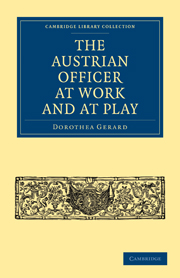Book contents
CHAP. II - A MANUFACTORY OF SOLDIERS
Published online by Cambridge University Press: 21 April 2011
Summary
It is interesting to note that no less a person than our own lion-hearted Richard is responsible for the existence of the Academy of Neustadt—the Babenberger Burg, from which it issued, having been built with the ransom paid by England for her captive king. The original castle was soon destroyed by an earthquake; but on its site another speedily rose, and became a favourite residence of the Habsburgers. Maximilian I, “the last knight,” lies buried in its chapel. After his death it served as a state prison more frequently than as a residence. Of the various political prisoners here interred, the most renowned was Rakoczy, the rebel Prince of Transylvania, who after spending a year in the tower which still bears his name, managed to effect an escape. As a refuge from epidemics in the capital, Neustadt likewise did good service to the Court. Its final transformation was the work of Maria Theresia, who in 1751 founded here an academy which, under the title of “Theresianische Militärakademie,” has remained the chief nursery of the Austrian army. From it many distinguished commanders and countless heroes have issued, who in ninety-five chief battles and in more than two thousand encounters have upheld Austria's honour.
It is therefore in a soil literally soaked in traditions that the “Neustädter” grows up. The very walls that surround him are eloquent of the past—thick, massive walls, from which frown row upon row of dusky portraits, claiming to represent Imperial army leaders of past times—starting with knights in armour, and ending with the traditional white uniform coat.
- Type
- Chapter
- Information
- The Austrian Officer at Work and at Play , pp. 186 - 215Publisher: Cambridge University PressPrint publication year: 2010First published in: 1913



